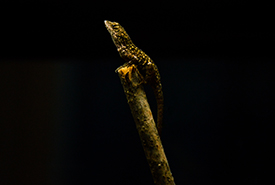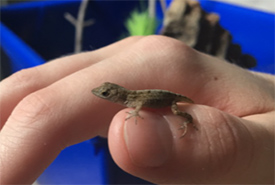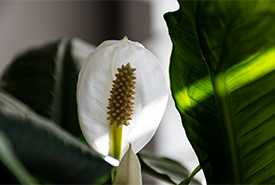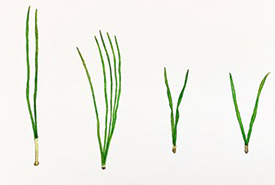NCC: Land Lines – Stanley the stowaway

Stanely on a branch (Photo by Andrea Moreau)
It was past midnight, and I was just wrapping up my school work for the day when I saw it: a tiny brown lizard, only slightly larger than my thumb nail. The lizard was so small (and I was so tired) that I had to do a doubletake; but there it was, perched atop my desk and looking at me almost as inquisitively as I looked at it. Who was this mystery lizard and, perhaps more importantly, how did it get in my house?

Baby Stanley, a few days after I found her. (Photo by Andrea J Moreau)
A quick Google search for “lizards native to Ontario” yielded one result: the common five-lined skink. However, within a few seconds of scrolling through the images, I quickly deduced that that was not the creature staring back at me. Upon searching for “small brown lizard,” I came across my answer: my new friend, who I named Stanley, was a brown anole. I would later discover that Stanley was a female, as she never developed a dewlap (a red fold of skin that male anoles have under their chins), but by then the name had stuck.
I was shocked to learn that the brown anole is native to Cuba and the Bahamas. The climatic conditions of these subtropical islands are in stark contrast to those here in Ontario — the last recorded snowfall in Cuba was in 1857! If I hadn’t invested in a heat lamp for her, she would not have survived here. However, the brown anole thrives in Florida, where coincidentally, the tropical peace lily plant I had just bought at the garden centre was imported from.
In the Sunshine State, the brown anole is highly invasive, and has outcompeted populations of the native green anole since its accidental arrival via cargo ship in the late 1800s. Brown anoles are slightly larger and more aggressive than their green cousins, taking over ground-level habitats while the green anoles are forced to escape them by moving higher, into tree canopies. The problem with this is that human activities such as urbanization and deforestation limit the availability of tall canopies, allowing the population of brown anoles to flourish, while green anole populations dwindle.

The peace lily plant Stanley likely hatched from. (Photo by Andrea J Moreau)
The answer to how exactly Stanley arrived here in Ontario isn’t entirely certain, but I can make an educated guess! The female brown anole lays a single egg every two weeks during breeding season, burying them in moist soil to cushion them from the elements before moving on to her next nesting site ⁷. So, Stanley’s mother was likely an invasive brown anole living in Florida, where she laid the egg in the soil of the peace lily pot that would be transported to Ontario shortly thereafter.
This may sound far-fetched, but it’s not actually an uncommon occurrence. On iNaturalist, a community science website where users can report sightings of plant and animal species, I found 30 reports of brown anoles that had made their way to Ontario within the last four years. Nearly every single post mentioned that the lizard in question had emerged from a potted plant or imported soil.

The physical differences between the brown anole, green anole, and common five-lined skink. (Illustration by Andrea Moreau)
Luckily, anoles are relatively common pets. In fact, my local pet store sells both green and brown anoles, so it was quite easy to learn about Stanley and how to care for her. She started off too small to eat much of anything besides fruit flies, but has quickly grown to 12 centimetres long and graduated to a balanced diet of crickets and mealworms.
While I’m happy to accommodate Stanley in my home, this experience really emphasized just how prevalent an issue the spread of invasive species is. Brown anoles were the first invasive reptile to arrive in Florida, but since then around 150 other species have followed suit. And while it may be too cold for brown anoles to pose any threat here in Ontario, we aren’t immune to other types of hitchhikers! In recent years, warming due to climate change has allowed invasive pests such as zebra mussels and emerald ash borer beetles to move in and begin wreaking havoc. Both of these species put our native plants and animals at risk by taking away their habitats, breeding areas and food sources.
So, what can you do to help combat the spread of invasive species? Unfortunately, once populations of invasive species become established it is difficult to control them, as they don’t typically have native predators; so, it is best to stop them in their tracks. If you see an invasive species, contact Ontario’s Invading Species Awareness Program to report it, so that they can remove the species before it gets out of control. Additionally, buying locally grown food and plants reduces the demand for imported products that may come with invasive species. On a broader level, the issue of invasive species is inextricably linked to other environmental issues, such as climate change. One way to do your part is by advocating for causes such as clean energy and sustainable development, and working to reduce your personal carbon footprint.
It’s important that we all do what we can to stop the spread of invasive species and protect our natural ecosystems and the animals that call them home. And, if I’m honest, I’m sure Stanley would rather be basking in the Caribbean sun than in a terrarium in Ontario.



